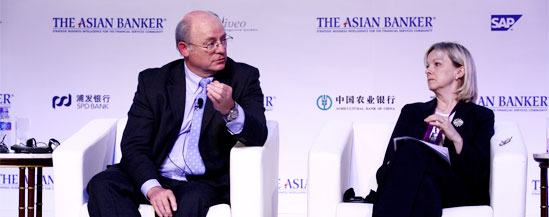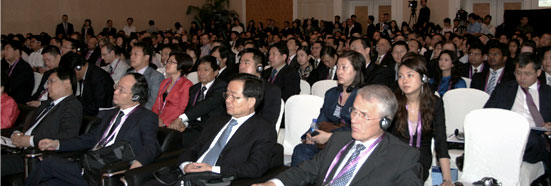 |
| • www.theasianbanker.com | • Calendar |
| 中文 |
In seeking answers to the global financial crisis, speakers and delegates at The Asian Banker Summit in Beijing looked at both what had gone wrong and what had been done right By Peter Hoflich and David Hendrickson The Asian Banker Summit opened Monday in Beijing, China with over 500 bankers gathering to hear opening keynotes from Liu Mingkang, chairman of the China Banking Regulatory Commission (CBRC), and Jeffrey Lacker, president of the Federal Reserve Bank of Richmond, before splitting into programmes for IT, risk and regulation, and transaction banking.
Extensive ground on business and operational issues were covered, and by the time delegates yesterday heard closing key notes from Julie Dickson, superintendent of Canada’s Office of the Superintendent for Financial Institutions (OSFI), and Malcolm Knight, vice chairman of Deutsche Bank and former general manager of the Bank for International Settlements, a greater understanding of regulatory thinking had been gained as well. Noting the differences between China’s tightly-controlled regulatory framework and that of other countries, Liu pointed out several areas where the Chinese regulator has been proactive in preventing potential problems in the financial system. As the supervisor of Chinese banks, three of which in 2008 became the world’s largest by market capitalisation, Liu noted in his speech that “regulators have put too much emphasis on the capital adequacy ratio, while paying little attention to reinforcing the capacity and structure of macro-prudential regulation. On the contrary, the CBRC has always kept a close eye on individual banking institution as well as systemic stability.” For Lacker, the challenge of improving a framework that has proven deficient has been in aligning the business structures and practices of banks with regulatory infrastructure and financial safety nets, both explicit and implicit. “Regulation supervision and the safety net go hand in hand. But they have to be evenly matched. The extent, scope and breadth of regulatory supervision have to be commensurate with the safety net. If you have a safety net that extends farther than the regulatory reach, that’s a recipe for disaster,” he said. While many of the difficulties that banks are dealing with today originated in the housing market, Liu notes that the CBRC has been approaching its supervision of the mortgage industry with care. “We tightened our oversight on credit to commercial real estate business by enforcing strict caps on the real estate company’s debt to equity ratio, and increased the mortgage rate for second or multiple house purchase, so as to prevent the real estate bubbles from spreading into the banking sector,” said Liu.
While Chinese banks have enjoyed healthy performance throughout the downturn of the past year, banks like Agricultural Bank of China (ABC), which will undertake an IPO after aggressively writing down NPLs, will need to be careful as they approach new business strategies. Dr Zhang Yun, president of ABC, noted that while the bank is seeking to engage in a ‘blue seas’ strategy of rural finance through an innovative business model, it still needs to overcome problems with infrastructure, staff skills, and risk management. Also discussed in the opening key notes were the controversial stress tests on which the Fed had just released reports. Lacker noted that the process involved 15-hour conference calls, while Teresa Curran, group vice president of banking regulation of the Federal Reserve Bank of San Francisco, mentioned in a later session that her office had 150 people working on the tests in a short period of time. But Curran is satisfied with the results, and now that the work has been done and the Fed is learning important lessons about how macroprudential and microprudential regulatory models can come together, she hopes that the programme can continue. Lessons in the process can be valuable for regulators and banks in other jurisdictions, and some are already showing interest in the process—Liu noted in his speech that Chinese banks are conducting stress tests, and the Korean regulator is considering conducting stress tests for its banks and brokerages on derivative products they sell. In addressing system and counterparty risk, Dickson of Canada’s OSFI noted the importance of macroprudential monitoring and focusing on the messages that can be drawn from it, but cautioned that linking capital requirements to macro indicators entails many challenges. “I think it is way too soon to say that is a viable policy option,” she maintained. At the same time, Dickson stressed that a number of concrete steps can be taken to improve system resilience, among them attention to capital quality, leverage controls, fixes to capital rules in specific areas such as securitisation and counterparty risk and greater liquidity and compensation scheme focus. “Future risks to banking are very difficult to predict at this time,” she added, putting the onus on banks to be highly prudent and supervisors to remain vigilant and avoid overselling their capabilities in light of the challenges.  Julie Dickson, superintendent, Office of the Superintendent for Financial Institutions Canada (right) and Malcolm Knight, vice chairman, Deutsche Bank and former general manager, BIS in discussion mode during the closing keynote’s dialogue session Julie Dickson, superintendent, Office of the Superintendent for Financial Institutions Canada (right) and Malcolm Knight, vice chairman, Deutsche Bank and former general manager, BIS in discussion mode during the closing keynote’s dialogue session
Deutsche’s Knight outlined his own diagnosis for managing systemic and counterparty financial risks. “Managing the on-going financial turbulence and simultaneously laying the foundation for building a new global architecture of financial regulation requires a comprehensive set of measures,” the former BIS general manager argued. Among his proposed requirements include new transparency and disclosure rules for financial instrument valuations, higher bank capital and liquidity and the introduction of macro prudential regulators. While emphasising the importance of expediting implementation of such measures, Knight meanwhile pointed out that their design and phasing in must be well coordinated globally, with Asia taking an increasingly centre stage. “China will play an important role in this process both because it is such a large contributor to the global economy and because a number of the policy measures that the Chinese authorities are implementing will be complimentary to those that are needed to be taken in the global economy to get us through these current difficulties,” he said. During the closing key notes as well, Morton Friis, chief risk officer of Royal Bank of Canada, stressed the challenge surrounding capital requirements and the calibration of banks’ risk measures to reflect perceived risks. “The regime we live under makes this difficult,” he said, adding that a consensus for addressing it is still weak. Yet, Qing Wang, chief economist for greater China at Morgan Stanley, observed that the crisis is an opportunity for the industry to take a critical leap in answering systematic and counterparty risk, akin to the Great Depression and advent of macroeconomic policymaking, and adopt a new framework for overcoming discord pertaining to areas such as market-to-market financial accounting rule implementation, ratings agency roles and bank regulation.
|
Official Host
Organised by
In Association with
Main Hosts of the Leadership Forum
Lead Sponsor
Lead Sponsor of the BAFT Asia Conference
Premier Sponsor of
Asian Banker Leadership Achievement Awards |

































